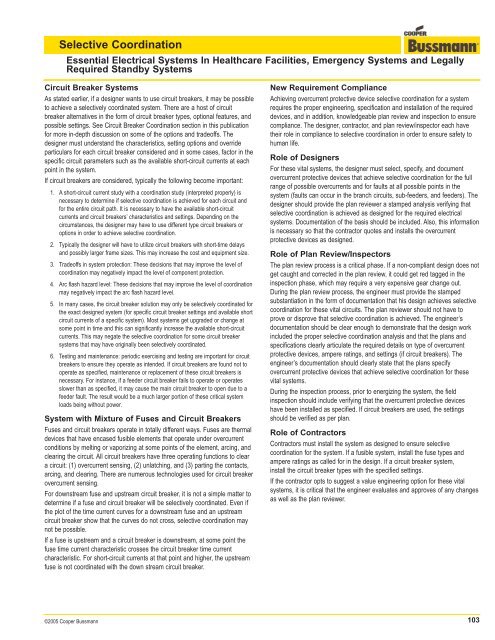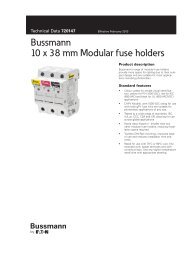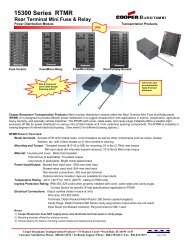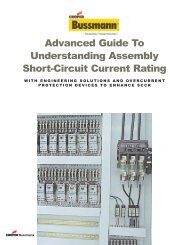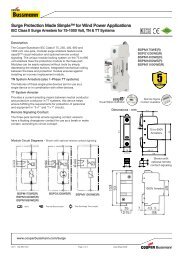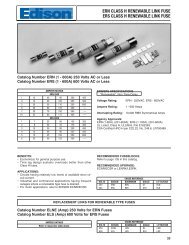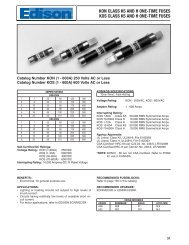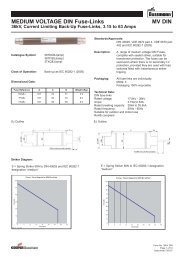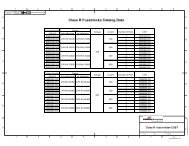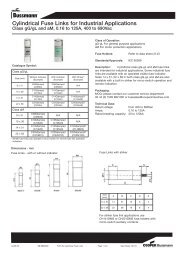Selective Coordination - Cooper Bussmann
Selective Coordination - Cooper Bussmann
Selective Coordination - Cooper Bussmann
Create successful ePaper yourself
Turn your PDF publications into a flip-book with our unique Google optimized e-Paper software.
<strong>Selective</strong> <strong>Coordination</strong>Essential Electrical Systems In Healthcare Facilities, Emergency Systems and LegallyRequired Standby SystemsCircuit Breaker SystemsAs stated earlier, if a designer wants to use circuit breakers, it may be possibleto achieve a selectively coordinated system. There are a host of circuitbreaker alternatives in the form of circuit breaker types, optional features, andpossible settings. See Circuit Breaker <strong>Coordination</strong> section in this publicationfor more in-depth discussion on some of the options and tradeoffs. Thedesigner must understand the characteristics, setting options and overrideparticulars for each circuit breaker considered and in some cases, factor in thespecific circuit parameters such as the available short-circuit currents at eachpoint in the system.If circuit breakers are considered, typically the following become important:1. A short-circuit current study with a coordination study (interpreted properly) isnecessary to determine if selective coordination is achieved for each circuit andfor the entire circuit path. It is necessary to have the available short-circuitcurrents and circuit breakers’ characteristics and settings. Depending on thecircumstances, the designer may have to use different type circuit breakers oroptions in order to achieve selective coordination.2. Typically the designer will have to utilize circuit breakers with short-time delaysand possibly larger frame sizes. This may increase the cost and equipment size.3. Tradeoffs in system protection: These decisions that may improve the level ofcoordination may negatively impact the level of component protection.4. Arc flash hazard level: These decisions that may improve the level of coordinationmay negatively impact the arc flash hazard level.5. In many cases, the circuit breaker solution may only be selectively coordinated forthe exact designed system (for specific circuit breaker settings and available shortcircuit currents of a specific system). Most systems get upgraded or change atsome point in time and this can significantly increase the available short-circuitcurrents. This may negate the selective coordination for some circuit breakersystems that may have originally been selectively coordinated.6. Testing and maintenance: periodic exercising and testing are important for circuitbreakers to ensure they operate as intended. If circuit breakers are found not tooperate as specified, maintenance or replacement of these circuit breakers isnecessary. For instance, if a feeder circuit breaker fails to operate or operatesslower than as specified, it may cause the main circuit breaker to open due to afeeder fault. The result would be a much larger portion of these critical systemloads being without power.System with Mixture of Fuses and Circuit BreakersFuses and circuit breakers operate in totally different ways. Fuses are thermaldevices that have encased fusible elements that operate under overcurrentconditions by melting or vaporizing at some points of the element, arcing, andclearing the circuit. All circuit breakers have three operating functions to cleara circuit: (1) overcurrent sensing, (2) unlatching, and (3) parting the contacts,arcing, and clearing. There are numerous technologies used for circuit breakerovercurrent sensing.For downstream fuse and upstream circuit breaker, it is not a simple matter todetermine if a fuse and circuit breaker will be selectively coordinated. Even ifthe plot of the time current curves for a downstream fuse and an upstreamcircuit breaker show that the curves do not cross, selective coordination maynot be possible.If a fuse is upstream and a circuit breaker is downstream, at some point thefuse time current characteristic crosses the circuit breaker time currentcharacteristic. For short-circuit currents at that point and higher, the upstreamfuse is not coordinated with the down stream circuit breaker.New Requirement ComplianceAchieving overcurrent protective device selective coordination for a systemrequires the proper engineering, specification and installation of the requireddevices, and in addition, knowledgeable plan review and inspection to ensurecompliance. The designer, contractor, and plan review/inspector each havetheir role in compliance to selective coordination in order to ensure safety tohuman life.Role of DesignersFor these vital systems, the designer must select, specify, and documentovercurrent protective devices that achieve selective coordination for the fullrange of possible overcurrents and for faults at all possible points in thesystem (faults can occur in the branch circuits, sub-feeders, and feeders). Thedesigner should provide the plan reviewer a stamped analysis verifying thatselective coordination is achieved as designed for the required electricalsystems. Documentation of the basis should be included. Also, this informationis necessary so that the contractor quotes and installs the overcurrentprotective devices as designed.Role of Plan Review/InspectorsThe plan review process is a critical phase. If a non-compliant design does notget caught and corrected in the plan review, it could get red tagged in theinspection phase, which may require a very expensive gear change out.During the plan review process, the engineer must provide the stampedsubstantiation in the form of documentation that his design achieves selectivecoordination for these vital circuits. The plan reviewer should not have toprove or disprove that selective coordination is achieved. The engineer’sdocumentation should be clear enough to demonstrate that the design workincluded the proper selective coordination analysis and that the plans andspecifications clearly articulate the required details on type of overcurrentprotective devices, ampere ratings, and settings (if circuit breakers). Theengineer’s documentation should clearly state that the plans specifyovercurrent protective devices that achieve selective coordination for thesevital systems.During the inspection process, prior to energizing the system, the fieldinspection should include verifying that the overcurrent protective deviceshave been installed as specified. If circuit breakers are used, the settingsshould be verified as per plan.Role of ContractorsContractors must install the system as designed to ensure selectivecoordination for the system. If a fusible system, install the fuse types andampere ratings as called for in the design. If a circuit breaker system,install the circuit breaker types with the specified settings.If the contractor opts to suggest a value engineering option for these vitalsystems, it is critical that the engineer evaluates and approves of any changesas well as the plan reviewer.©2005 <strong>Cooper</strong> <strong>Bussmann</strong>103


